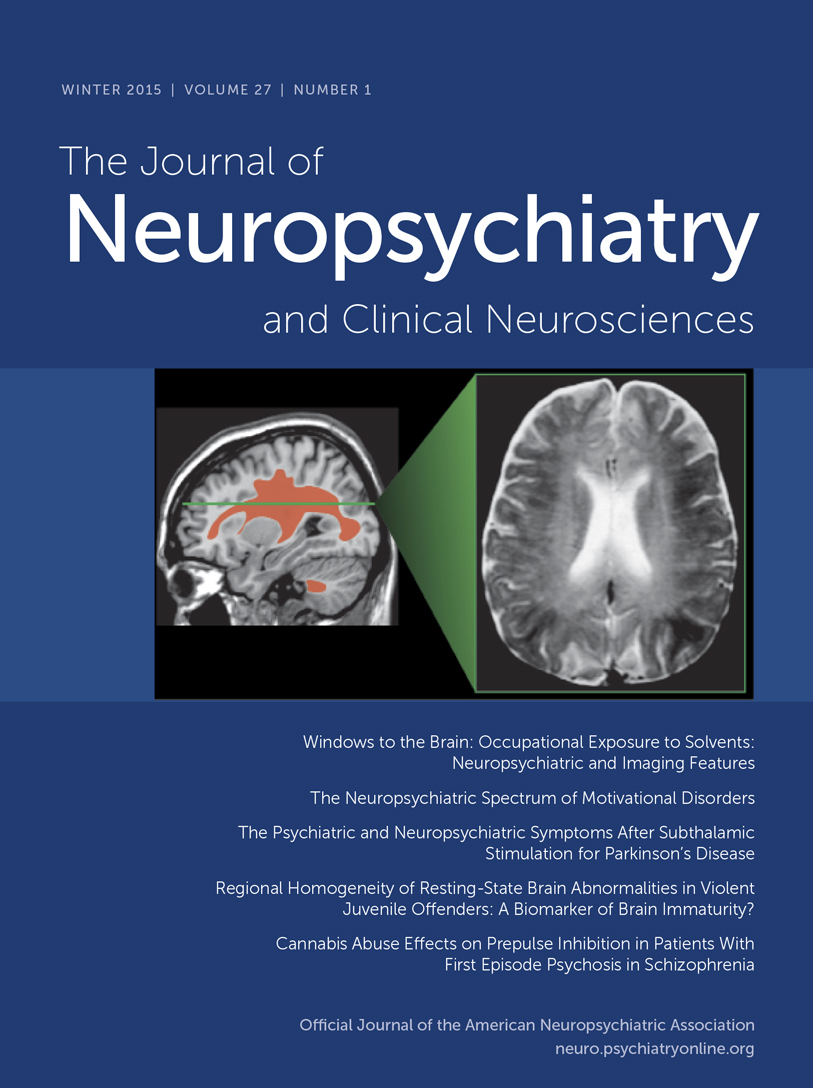Visual Hallucinations: A Treatment-Emergent Adverse Effect of Linezolid
To the Editor: The authors report an unusual adverse effect of linezolid in a 49-year-old man who developed visual hallucinations after initiation of linezolid, which subsided with discontinuation of linezolid. Relevant differential diagnoses are also discussed in this report.
Case Report
“Mr. K,” a 49-year-old man, presented with intermittent fever for 12 days and a foul-smelling blackish discharge in the perianal region for 3 days. He was diagnosed with Forniers gangrene, and after emergency debridement, he was started on oral tramadol 100 mg three times a day for postoperative pain symptoms. A pus culture showed Escherichia coli and Enterococcus fecalis sensitive to linezolid, and Mr. K. was thus started on intravenous linezolid 600 mg twice per day (weight, 55 kg). On the third day of linezolid, the patient had an abrupt onset of incessant vivid visual hallucinations with acting out in clear consciousness associated with sleep disturbance. Delusions, hallucinations in another modality, altered sensorium, substance use, or organicity were not noted. His past and family history were not contributory. On examination, he was afebrile with deep tendon reflexes with a normal response, had Babinski- Plantar flexion on both sides, and had no neck stiffness. A serial Mini Mental State Examination (MMSE)1 was normal (30/30). A laboratory investigation showed the following: total white blood cell count, 7000; serum sodium level, 138 mEq/L; potassium level, 4.5 Eq/L; thyroid-stimulating hormone level, 2.38 μIU/mL; creatinine level, 0.7 mg/dL; and SGOT, 45 IU/L. A brain CT scan showed normal brain parenchyma. As the onset of hallucinations was temporally correlated with the use of medications, drug-induced hallucinations were suspected. Thus, linezolid was stopped 3 days after the onset of hallucinations. A decrease in the frequency of the visual hallucinations was noted by the second day after stopping linezolid, and they ceased by the third day. Hallucinations did not recur during the 3-months follow-up period.
Discussion
The possibility of an acute confusional state was ruled out in view of the serial MMSE score being 30/30 and the absence of delirium as per the algorithm based on the Confusion Assessment Method.2 There were no clinical signs of serotonin syndrome. Because the patient showed remarkable improvement within a day of cessation of linezolid, drug-induced hallucinations were suspected on the background of a proserotoninergic drug like tramadol. A score of 6 was obtained in the Naranjo adverse drug reaction probability scale,3 suggestive of possible drug-induced hallucinations.
Linezolid, being a weak nonselective inhibitor of monoamine oxidase, tends to increase the synaptic concentrations of biogenic amines (e.g., dopamine, norepinephrine, and serotonin), resulting in serotonin syndrome, especially in the presence of a proserotoninergic agent.4 Subsequently, delirium with visual hallucinations after addition of intravenous diphenhydramine with linezolid was reported, hypothesizing that linezolid induced hyperdopaminegia.4 In a study to compare uptake of radiolabeled 5-hydroxytryptamine (5-HT) and dopamine by human SERT, it was found that dopamine uptake by hSERT was more vulnerable to be inhibited than 5-HT uptake, especially in the presence of inhibitors of hSERT like a selective serotonin reuptake inhibitor or a proserotoninergic agent. Such a raised dopamine/5HT ratio in areas where the DAT/SERT ratio is already low, such as the prelimbic medial prefrontal cortex and nucleus accumbens shell, may lead to psychotic symptoms.5 We hypothesize that a complex 5HT–dopamine interaction could explain the differential expression, with symptoms of psychosis in some and serotonin syndrome in others. Further research of the 5-HT–dopamine interaction may lead us to a better understanding of the pathophysiology of schizophrenia.
1 : Psychometric properties of the Folstein Mini-Mental State Examination. Assessment 2005; 12:137–144Crossref, Medline, Google Scholar
2 : Sternberg EJ eta l: The Confusion Assessment Method (CAM): A Systematic Review of Current Usage. J Am Geriatr Soc 2008; 56:823–830Crossref, Medline, Google Scholar
3 : A method for estimating the probability of adverse drug reactions. Clin Pharmacol Ther 1981; 30:239–245Crossref, Medline, Google Scholar
4 : Acute delirium associated with combined diphenhydramine and linezolid use. Ann Pharmacother 2004; 38:62–65Crossref, Medline, Google Scholar
5 : Dopamine transport by the serotonin transporter: a mechanistically distinct mode of substrate translocation. J Neurosci 2011; 31:6605–6615Crossref, Medline, Google Scholar



